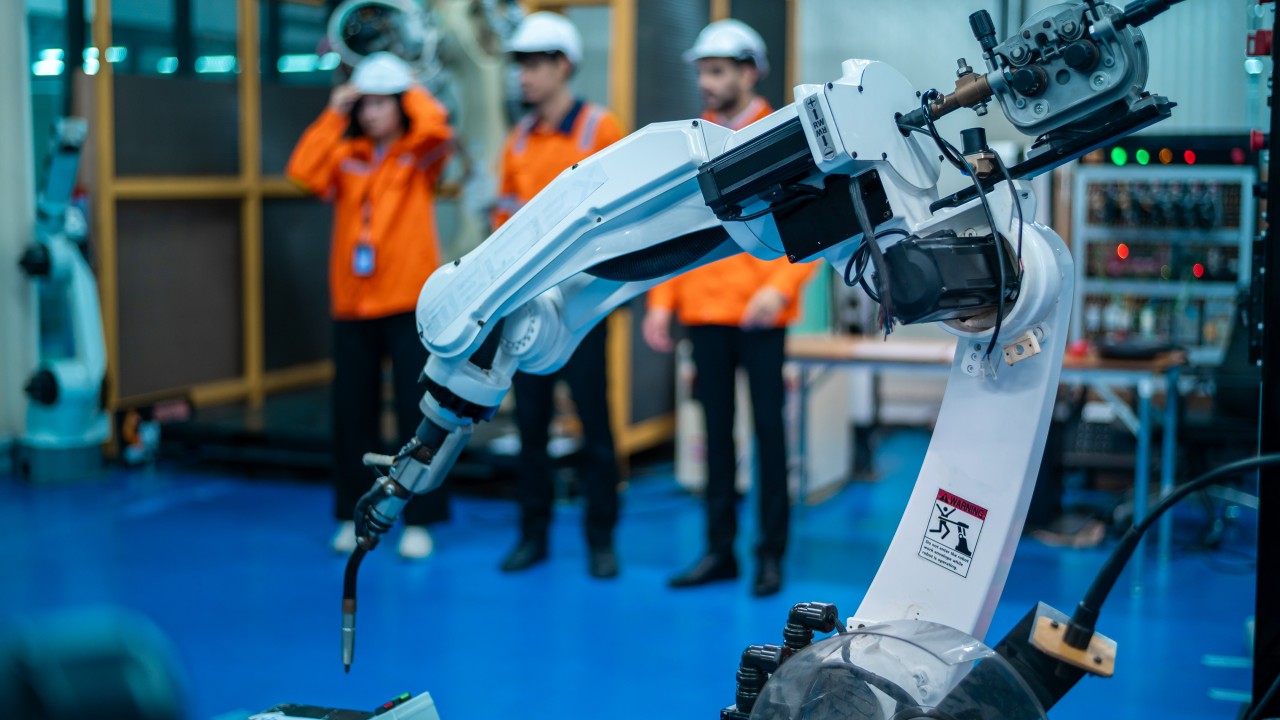
Self-Propelled Missiles: How To Find and Work with High
Some call them “Self-propelled missiles” this often refers to individuals who are driven, focused, and capable of achieving their goals independently with little to no external supervision. They are proactive problem-solvers, highly motivated, and thrive in environments where they can take ownership of their tasks. These individuals align themselves with the mission and have a clear sense of purpose, making them invaluable assets in any team or organization.
Characteristics of Self-Propelled Missiles:
Intrinsic Motivation: They are driven by internal goals, curiosity, or a passion for excellence rather than external rewards.
Proactivity: They anticipate challenges, seek opportunities, and take initiative without waiting for instructions.
Accountability: They own their successes and failures, constantly seeking ways to improve.
Problem-Solving Skills: They thrive in ambiguity and are adept at finding creative solutions.
Resilience: They bounce back quickly from setbacks, maintaining focus on their objectives.
Strategic Thinking: They prioritize effectively, focusing on high-impact activities.
Clear Communication: They know how to ask for resources or guidance when necessary but work autonomously most of the time.

How to Identify Them (To work with Them):
Now Like most others you are probably wondering, do I fit in this category and where can I find these people?
Through Interviews:
Ask for Specific Examples: Pose questions that reveal self-motivation, such as, “Tell me about a time you accomplished something significant without being asked.”
Focus on Ownership: Look for candidates who naturally use language like “I took the lead,” “I initiated,” or “I resolved.”
Behavioral Tests:
Use personality assessments to gauge traits like independence, conscientiousness, and perseverance.
Past Performance:
Review resumes or portfolios for evidence of entrepreneurial efforts, solo achievements, or projects that required high levels of autonomy.
Speak to references to confirm their work style.
Trial Assignments:
Give potential hires a project or challenge with minimal guidance and evaluate how they handle it.
Past Performance:
Check their history for signs of thought leadership or self-initiated projects.
How to Best Work with High Achievers:
When working with achievers on your team it is good to know what they like most, here are a couple of tips.
Provide Autonomy:
Let them take ownership of their tasks and allow them to make decisions within their scope of work.
Set Clear Goals and Expectations:
Define the “what” and the “why,” but let them determine the “how.”
Offer Resources, Not Micromanagement:
Be available to remove roadblocks and provide tools, but avoid over-directing their efforts.
Encourage Feedback Loops:
Create opportunities for regular updates or check-ins without imposing unnecessary oversight. Use these moments to align on priorities rather than review every detail.
Provide Opportunities for Growth:
Assign challenging projects that allow them to showcase their creativity and initiative.
Recognize Their Achievements:
Acknowledge their efforts and celebrate their successes. High performers often value recognition of their independence and impact.
Facilitate Collaboration When Needed:
While they excel independently, provide opportunities for them to lead teams or contribute to collaborative projects.

Rare like precious metals…..where can I find these people?:
Finding these rare inventors and creators of the future isnt easy. Here are some places to find these people since you likely want to work with them. And chances are if you are also a high achiever you will find some friends with similar values and ambitions.
Communities of High Performers:
Attend hackathons, startup meetups, or industry conferences where ambitious individuals often gather.
Niche Talent Platforms:
Use platforms like Toptal, AngelList, or specialized LinkedIn groups to find individuals with a track record of autonomy.
Universities and Alumni Networks:
Partner with programs or organizations that attract driven individuals, such as entrepreneurship centers.
Look for Side Projects:
Candidates with side hustles, passion projects, or prior entrepreneurial efforts often exhibit self-propulsion.
Recommendations:
Ask for referrals from trusted colleagues or industry leaders who know people with these traits.
By identifying, recruiting, and empowering these individuals, you’ll build a team that drives itself forward and achieves exceptional results with minimal input—allowing you to focus on strategy and big-picture goals.

Indicators of Future High Achievers:
Certain life experiences, personality traits, and environmental factors can shape people into being “self-propelled missiles.” These indicators don’t guarantee that someone will have this quality, but they increase the likelihood of independence, resilience, and high intrinsic motivation. Here are some common predictors:
Upbringing and Life Circumstances
Growing Up with Immigrant Parents:
Immigrant families often emphasize hard work, self-reliance, and resourcefulness due to the challenges they face. Many children in these households internalize these values and learn to navigate complex situations independently.
They may have had to translate for parents, advocate for themselves, or navigate unfamiliar systems, developing initiative and problem-solving skills early.
Early Exposure to Responsibility:
Children who were expected to take on significant responsibilities (e.g., caring for siblings, managing household tasks, or working while in school) tend to develop self-discipline and a strong sense of ownership.
Adverse Life Events:
Overcoming challenges like financial instability, loss, or other hardships often fosters resilience, adaptability, and the drive to take control of their circumstances.

Personality Traits
High Conscientiousness:
These individuals tend to be organized, dependable, and persistent, which correlates with self-motivation and accountability.
Curiosity and Open-Mindedness:
People with high curiosity actively seek new opportunities and solutions, making them proactive learners and doers.
Self-Efficacy:
A strong belief in their ability to influence outcomes is a key predictor of independent success.
Grit and Perseverance:
Individuals who demonstrate the ability to sustain long-term effort toward goals, especially through difficulties, are likely to thrive with minimal supervision.

Past Experiences
Entrepreneurial Ventures:
Anyone who has started a business, even if it failed, has demonstrated initiative, self-reliance, and an ability to manage uncertainty.
Side Hustles or Passion Projects:
Self-started projects, hobbies, or freelance work indicate intrinsic motivation and a willingness to take action without external pressure.
Work History in Autonomy-Driven Roles:
People who have succeeded in roles with minimal oversight, such as remote work, consulting, or freelance jobs, have already proven they can handle independence.
Participation in Competitive Environments:
High performers in competitive sports, debate, chess, or other skill-driven activities often have self-discipline and a strong drive to improve.
Education and Learning Style
Self-Taught Skills:
People who have taught themselves skills (e.g., programming, design, a new language) without formal instruction show initiative and the ability to manage their learning process.
Experience with Rigorous or Unstructured Learning:
Attending schools or programs that emphasize independent thinking (e.g., Montessori schools or research-focused universities) can foster these traits.
Social and Cultural Background
Cultural Expectations of Excellence:
In some cultures, there is strong pressure to excel academically or professionally, instilling a “work hard and figure it out” mindset.
Recommended by LinkedIn
Exposure to Diverse Experiences:
People who have lived in different countries, moved frequently, or grown up in multicultural environments tend to adapt quickly, solve problems creatively, and navigate ambiguity well.
Psychological Indicators
Intolerance for Complacency:
Look for people who are dissatisfied with “good enough” and continually push themselves to achieve more.
Internal Locus of Control:
These individuals believe that they are in control of their outcomes, rather than external forces or luck, driving them to take action.
High Emotional Intelligence:
People with strong self-awareness, empathy, and interpersonal skills often manage their own goals effectively while working well with others when needed.

How to Spot These Indicators in Candidates:
If you are working for a company and targeting high achieving individuals here are some things you can do to stack the odds in your favor.
Behavioral Questions in Interviews:
Ask about specific instances where they solved problems, initiated projects, or overcame challenges. Example: “Tell me about a time when you had no guidance or clear path forward—what did you do?”
Look for Patterns in Their Story:
Did they show early signs of independence (e.g., working during school, starting initiatives)?
Do they share stories of overcoming obstacles or taking control of situations?
Body of Work:
Review their portfolio, LinkedIn, or any public record of achievements. Look for a track record of initiating or excelling in high-autonomy tasks.
Reference Checks:
Ask former colleagues or managers, “How well did this person manage themselves? Did they seek solutions independently?”
While factors like growing up with immigrant parents or facing adversity can build resilience and initiative, the best way to predict whether someone will be a self-propelled missile is to assess their patterns of behavior—how they have acted in situations requiring autonomy, initiative, and grit. Look for evidence in their past experiences, values, and personality, and provide them with an environment where they can thrive through ownership and minimal supervision.

Statistically Speaking:
Individuals who exhibit the traits of “self-propelled missiles” or high intrinsic motivation tend to be statistically higher performers, particularly in environments that reward autonomy, initiative, and problem-solving. Here’s why:
Why They Are Higher Performers:
Intrinsic Motivation Drives Excellence:
- Why It Matters: People who are intrinsically motivated work for the satisfaction of achieving their goals, not just external rewards like money or praise. This leads to higher engagement, persistence, and quality of output.
- Research Insight: Studies in organizational psychology show that intrinsic motivation is strongly correlated with creativity, productivity, and job satisfaction.
They Operate Proactively:
- Why It Matters: Instead of waiting for instructions, these individuals anticipate problems, identify opportunities, and act before being asked. This reduces delays, streamlines workflows, and ensures consistent progress.
- Supporting Data: Research by Gallup highlights that employees who take initiative are 43% more productive than those who only respond to assigned tasks.
They Learn and Adapt Quickly:
- Why It Matters: High performers are often lifelong learners who teach themselves new skills, adapt to changing environments, and thrive in ambiguity. Their ability to self-educate and iterate makes them more effective over time.
- Example: In a fast-changing industry like technology, people who learn independently tend to outperform those waiting for formal training.
Resilience Enhances Long-Term Success:
- Why It Matters: These individuals can bounce back quickly from failure, using setbacks as learning experiences. Resilience is a predictor of both performance and career success.
- Research Insight: Angela Duckworth’s research on “grit” found that perseverance and passion for long-term goals are better predictors of success than IQ or talent.
They Save Time for Managers:
- Why It Matters: Self-driven individuals require less supervision, freeing up leaders to focus on strategy rather than micromanaging. This amplifies the overall productivity of the team.
- Data Point: A McKinsey study found that teams with highly autonomous members achieve 20-25% higher efficiency because leaders can delegate more effectively.
Accountability Drives Results:
- Why It Matters: These individuals take ownership of their tasks and outcomes, ensuring they follow through on commitments. This accountability minimizes errors and enhances trust within teams.
- Example: In high-stakes environments like startups, accountability and initiative often separate high performers from average ones.
Emotional Intelligence (EQ) Improves Collaboration:
- Why It Matters: Many self-driven individuals also excel at managing emotions, building relationships, and navigating team dynamics. This makes them valuable collaborators and leaders.
- Data Insight: Studies have shown that EQ is responsible for 58% of success in professional roles, particularly leadership.

Statistical Evidence Supporting Their Performance:
This isn’t all lip service. And many may ask why even bother? The main reas0ons people want to find and work with these humans are as follows.
10x Productivity:
Google’s research on high-performing employees found that the top 1% of talent (often self-driven individuals) can be 10x more productive than average employees. This stems from their ability to work autonomously, innovate, and manage their time effectively.
High Initiative = High Performance:
A study by Bain & Company revealed that employees who demonstrate proactive behaviors (initiative and ownership) perform in the top 20% of their organizations across metrics like goal completion and leadership potential.
Resilience as a Success Predictor:
Research in education and workforce development has consistently found that individuals with strong resilience and grit achieve higher grades, job performance ratings, and long-term career success.
Entrepreneurial Drive = Better Outcomes:
Employees with entrepreneurial mindsets (e.g., those who started side projects or businesses) tend to outperform others in roles requiring innovation or independence. They are 25% more likely to be promoted within their first year, according to LinkedIn’s Workforce Insights.
Why These Traits Lead to Better Performance:
Higher Engagement Levels:
Self-driven individuals are more engaged because they derive satisfaction from their work. Engagement, in turn, is linked to better performance, retention, and innovation.
Efficient Problem Solving:
They spend less time waiting for instructions and more time solving problems. This agility allows them to adapt to challenges and deliver results faster.
Stronger Alignment with Goals:
These individuals are often highly aligned with their personal and organizational goals, ensuring their efforts have meaningful impact.
Greater Ownership Mentality:
When people take personal responsibility for outcomes, they tend to over-deliver because they see success or failure as a reflection of themselves.
Capacity to Scale Impact:
These individuals often create systems or innovate processes that benefit their entire team, scaling their value beyond individual tasks.
Self-propelled individuals tend to be higher performers because their intrinsic motivation, resilience, adaptability, and accountability allow them to achieve superior results with less management intervention. By identifying these individuals through their past behavior, personality traits, and experiences, organizations can build high-performing teams that excel under any circumstance.

Birds of a Feather….Fly Together:
Did you know that high-performing, self-driven individuals often prefer to work with other high performers?
Here’s why:
Shared Standards of Excellence
- Why They Prefer It: High performers set high standards for themselves and expect the same from others. Collaborating with similarly driven individuals ensures that everyone is equally committed to delivering high-quality results.
- Outcome: Fewer frustrations due to missed deadlines or subpar work, which allows them to focus on impactful contributions rather than compensating for others.
Increased Efficiency and Productivity
- Why They Prefer It: Working with high performers minimizes time spent on oversight, hand-holding, or reworking poor-quality outputs. High performers appreciate streamlined collaboration where everyone contributes effectively.
- Outcome: Faster progress toward goals and the ability to tackle more ambitious challenges.
Intellectual Stimulation
- Why They Prefer It: High performers thrive in environments where they are challenged intellectually. Working with other skilled and motivated individuals provides opportunities to learn, exchange ideas, and push creative or strategic boundaries.
- Outcome: A dynamic environment where innovation and growth are more likely to occur.
Mutual Inspiration and Motivation
- Why They Prefer It: Being surrounded by equally driven peers can be energizing. High performers often feed off the enthusiasm, ambition, and success of others, pushing themselves to achieve even more.
- Outcome: A positive cycle of mutual encouragement that leads to higher levels of achievement for the entire group.
Faster Problem Solving
- Why They Prefer It: High performers value efficiency and dislike bottlenecks. Other high performers tend to be proactive and solutions-oriented, which leads to quicker resolutions and better decision-making.
- Outcome: Collaboration becomes a catalyst for success rather than a hindrance.
Reduced Frustration
- Why They Prefer It: High performers often become frustrated when working with those who lack drive or initiative. Collaborating with equally motivated individuals reduces the friction caused by differing work ethics or commitment levels.
- Outcome: A more harmonious and productive work environment.
Better Opportunities for Personal Growth
- Why They Prefer It: High performers are often lifelong learners who seek to grow their skills and knowledge. Being part of a team of high performers exposes them to new perspectives, techniques, and insights that elevate their own performance.
- Outcome: Accelerated personal and professional development.
Shared Vision and Goals
- Why They Prefer It: High performers are often goal-oriented and results-driven. Collaborating with others who share the same focus ensures alignment and reduces conflict over priorities or direction.
- Outcome: A more cohesive team dynamic with a clear sense of purpose.
Preference for Meritocracy
- Why They Prefer It: High performers value environments where effort and results are recognized and rewarded. When surrounded by other high performers, they trust that success is merit-based rather than dependent on politics or favoritism.
- Outcome: Increased motivation and satisfaction in the workplace.
Desire to Avoid Burnout
- Why They Prefer It: When high performers work with less motivated teammates, they often take on extra work to ensure quality results, leading to burnout. Collaborating with other high performers helps distribute the workload more evenly.
- Outcome: Sustainable performance without overburdening a single individual.
Do High Performers Ever Avoid Other High Performers?
While high performers generally enjoy working with peers of similar caliber, there are exceptions:
- Competitive Environments: If the team dynamics foster unhealthy competition rather than collaboration, high performers may feel undermined or demotivated.
- Ego Clashes: High performers with strong egos may struggle to collaborate if they feel their ideas or contributions are being overshadowed.
- Micromanagement Risk: If a high-performing team attracts overly controlling leadership, it may stifle autonomy, a key motivator for these individuals.
High performers overwhelmingly prefer to work with others like themselves because it leads to greater efficiency, innovation, and satisfaction. They value collaboration that pushes them to grow, ensures high standards, and aligns with their ambitious goals. Creating an environment where high performers can collaborate productively is key to unlocking their full potential as individuals and as a team.
High performers, often described as self-driven individuals with intrinsic motivation and a proactive mindset, are invaluable to any team.
Studies show that top talent can be up to 10x more productive than average employees (Google), while teams with proactive members achieve 20-25% higher efficiency (McKinsey).
These individuals thrive on autonomy, solve problems quickly, and elevate the entire team’s performance through their high standards and collaborative energy. Seeking and hiring high performers isn’t just beneficial—it’s transformative, leading to greater innovation, productivity, and long-term success.
At GAME PILL , we’re passionate about building a team of ambitious, driven professionals who want to make an impact in the gaming industry.
If you’re a high performer looking to work with like-minded individuals on cutting-edge projects, we invite you to apply at gamepill.com and join us in creating extraordinary experiences.








